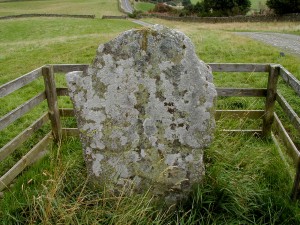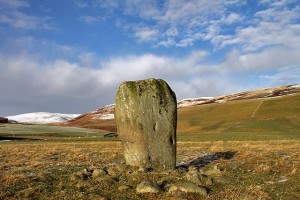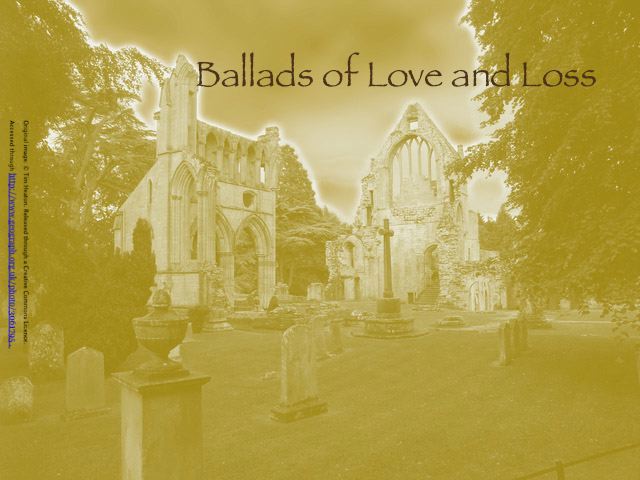The Dowie Dens of Yarrow
Scott first published this ballad in the 1803 edition of the Minstrelsy of the Scottish Border, where it appears in the third volume. He noted that it was the first time that the ballad had appeared in print. He placed it under the “Historical” heading, as the tales was, according to Scott, “universally believed to be founded in fact” among the people of Ettrick Forest. The version he presented was a collation of several copies which had been collected for the purpose of inclusion in the Minstrelsy, including a version collected by James Hogg, who was one of Scott’s collaborators.
This ballad is still popular with ballad singers, not only in Scotland but also in the USA. Numerous version have been recorded and, in general, those which are not fragmented fall into two categories.
The first can be defined as the “noble lord” category, where two nobles, having been drinking, resolve to fight each other. These versions usually begin with a verse which remarks on the lateness of the hour and the fact that they have been drinking, such as:
 :
Late at e'en, drinkin the wine, And ere the paid the lawing. They set a combat them between, To fecht it in the dawnin.
Here, the dispute is either unspecified, or one lord’s relationship with the sister of the other is implied as being reason for the fight.
The second group can be defined as the “ploughboy” category, where the lady has rejected the advances of lords in preference for a ploughboy. The reason for the fight in these versions is his audacity in loving or marrying a noble lady and her brothers’ outrage at the match. The version Scott published can be said to be part of the “noble lord” category.
History and Tradition
One of the reasons that Scott may have been eager to include this ballad is that the families who were said to have been involved with the feud that is presented were of the name Scott.
 Scott suggested one historical foundation for the tale, which he, in turn, had received from Hogg. He noted that the hero was of the surname Scott and he lived at Kirkhope, or Oakwood, castle. This provided a direct link with his own ancestry, as Sir Walter Scott could trace his own line to Walter Scott of Harden – Wat of Harden, who has a parallel in the ballad “Jamie Telfer of the Fair Dodhead”. Scott surmises that this hero might have been the John Scott of Harden, who was murdered by the Scotts of Gilmanscleuch.
Scott suggested one historical foundation for the tale, which he, in turn, had received from Hogg. He noted that the hero was of the surname Scott and he lived at Kirkhope, or Oakwood, castle. This provided a direct link with his own ancestry, as Sir Walter Scott could trace his own line to Walter Scott of Harden – Wat of Harden, who has a parallel in the ballad “Jamie Telfer of the Fair Dodhead”. Scott surmises that this hero might have been the John Scott of Harden, who was murdered by the Scotts of Gilmanscleuch.
Scott is careful, however, to couch his personal assertions in cautious language: he uses words and phrases such as “alleged”, “probable”, “is said to have been” and so on, ensuring that his own preferences for these anecdotes to prove factual cannot be taken as absolute fact.
Scott, however, reconsidered this supposition and by the 1833 edition (published posthumously), Scott suggests that the ballad referred to a duel or fight between John Scott of Tushielaw and Walter Scott of Thirlestane in 1609, in which Scott of Thirlestane was killed. The families, after this, were at feud. In 1616 one Walter Scott of Tushielaw made “an informal and inordinate marriage with Grizel Scott of Thirlestane” and three months later, a groups of Scotts were summoned to appear before the presbytery in Melrose to be excommunicated for the “horrible slaughter of Walter Scott of Tushielaw”.
 Scott was sensitive to the local tradition surrounding this ballad, and he concludes his remarks with information regarding two large stones which stand on the spot where the hero and his killer are said to have fought:
Scott was sensitive to the local tradition surrounding this ballad, and he concludes his remarks with information regarding two large stones which stand on the spot where the hero and his killer are said to have fought:
… the place of the combat is still called Annan's Treat. It is a low moor, on the banks of the Yarrow, lying to the West of Yarrow kirk. Two tall unhewn masses of stone are erected, about eighty yards distant from each other; and the least child, that can herd a cow, will tell the passenger, thare there lie “the two lords, who were slain in single combat.” (MSB (1803) III 73)
What is interesting is that this tradition persists. In 2012, the Borders farmer and ballad singer Henry Douglas told members of this project that when he was a young boy, his father pointed out the spot on the Dens of Yarrow where the fight supposedly took place.
All that can be surmised from this, in terms of the ballad, is that the events protrayed in it may not be so very far from the fact in terms of familial enmity and romantic connections.
There are, however, two Scandinavian ballads which Francis James Child mentioned in his prefatory notes to “The Braes of Yarrow” grouping, which seem to have similar storylines. He notes that “Herr Helmer” / “Herr Helmer Blau” presents a hero, who has married a lady, with whose family he is at feud. He meets her seven brothers and fights them all. He kills six of them, but spares the seventh, who kills him. In “Jomfruen i Skoven”, the hero passes the night with a lady in a wood, and she warns him to avoid her seven brothers. However, he faces them and tries to persuade them to let him marry their sister. There is a fight, in which all seven of the brothers and the hero are killed.
This is not to say that there is not a Scottish, if not specifically Border, basis for “ The Dowie Dens of Yarrow”, simply that there are similar tales extant in the ballad traditions of other countries. Opposition to a suit or a marriage may have been common enough, and it would be but a small step to inflate the numbers involved to better fit with the narrative conventions of a ballad.
“The Dowie Dens of Yarrow” is notable for its extremely constrained rhyme scheme. Out of 15 verses, “Yarrow” is the rhyme in 14 of them. On paper, this can appear rather repetitive, but when sung, this can be an extremely powerful ballad.
___________________
Image Credits
Image of the Yarrow Stone
